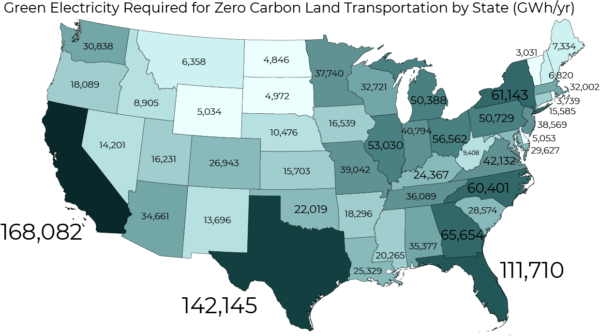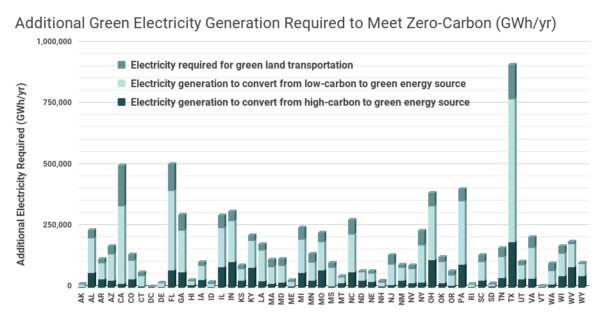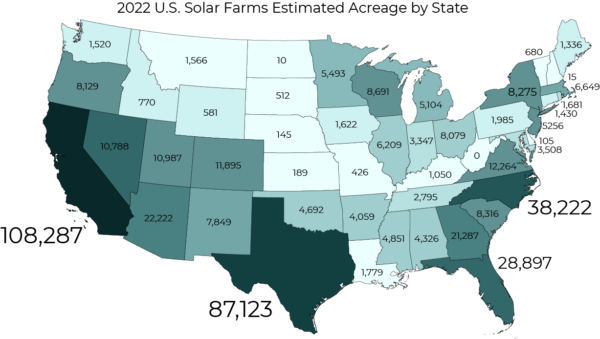By dedicating about 1% of the country’s land to solar energy—an area roughly the size of Kentucky—we could enable the nation to power itself with zero carbon emissions.
In conversations about energy, terms like “carbon neutral” and “net-zero goals” are often thrown around. Frequently, these discussions center around grid infrastructure, incentives and the viability of reaching a renewable energy future. But typically overlooked is another critical question: what do these goals actually mean for the land of America, i.e., how much acreage will be required for the country to achieve a grid with zero carbon emissions.
According to our calculations, assuming fossil fuel and biomass energy would be replaced with green energy, it would take approximately 13 million acres of land to power today’s grid solely from solar facilities. It should be noted, however, that this amount would likely need to double to account for energy storage, electric vehicle (EV) charging stations, and the necessary increase in electrical infrastructure. But by dedicating about 26 million acres or 1% of the country’s land to solar energy—an area roughly the size of Kentucky—we could enable the nation to power itself with no carbon emissions.
Figure 1 shows the country’s current electricity production broken down by source (as of May 2022). “Green” energy includes solar, wind, hydroelectric, and geothermal electricity. “Nuclear” energy is considered a zero-carbon electricity generation method. “Low-carbon” energy is natural gas, which the European Union is trying to include, amid controversy, as a type of green energy, meeting the carbon goals. “High-carbon” electricity is produced from coal, petroleum, and biomass sources. (Even though biomass is a renewable energy source, it requires burning wood and plants, creating problematic carbon emissions.)
To calculate the electricity demand for the United States, both infrastructure electricity and land transportation data were incorporated into this study. According to an EIA study, on-road passenger transportation accounts for 62% of transportation energy use in the U.S., with the rest being freight transportation (19%), marine (12%), air (5%), and rail (2%).
Assuming that only land transportation (on-road passenger, freight, and rail) can be completely electrified, we took driving statistics from the U.S. Department of Transportation and estimated the average yearly car mileage per driver for each state, which ranges from 7,013 miles per year for the District of Columbia to 24,069 miles per year for Wyoming. Combined with the number of licensed drivers for each state, we derived the yearly mileage per state for on-road passengers.
Since EVs in the U.S. account for less than one percent of all vehicles and we are not modeling an increase in the number of drivers, we will assume for our calculations that all vehicles are petroleum-based. Using an average EV energy consumption of 350 Wh (Watthour) per mile, and with more modeling, we converted this to a total energy consumption to turn the entire passenger vehicle fleet, along with freight and rail transportation, to electric (See Figure 2.)

Utility-scale generators in the United States currently generate around 4.7 million GWh per year, with 1.8 million GWh produced from high-carbon emission sources of energy and 1.6 million GWh from low-carbon emission natural gas. The electricity needed to make land transportation totally zero-carbon is estimated at 1.6 million GWh per year. To bring the current electricity production and land transportation to zero-carbon standards will require five million GWh per year of additional electricity generation from green energy. (Figure 3 and Figure 4 show the breakdown of this additional green electricity required for each state to have no carbon emissions.)

A key question in determining how much land is needed is what source of green energy will be used to produce these five million GWh per year of additional electricity. Growing calls for removing hydroelectric dams combined with increasing droughts — such as the one at the Glen Canyon Dam in Arizona’s Lake Powell where water levels have dropped to a historic low — do not make new hydroelectric dams likely. Wind farms take more acreage than solar to produce the same electricity, but they allow use of the land.

To simplify this analysis, we will assume that all the additional electricity from green energy sources will come from solar farms. Using the solar irradiance, topography, exclusion zones and buildable acreage specific to every state, we calculated the acreage required to generate this additional electricity on a per-state basis. (Figure 5)

Solar farms in the U.S. built and being built to date currently occupy an estimated half million acres. Adding up the required additional acreage across all 50 states, we would need an additional 13 million acres of solar farms in the next decade to meet the zero-carbon goals, over 25 times more than what has been built to date (Figure 6.). Reaching this reality would also require additional energy storage and infrastructure like transmission lines, substations, and distribution lines, which could be roughly estimated at another 13 million acres. This Kentucky-size acreage required for green electricity production, transportation, and storage represents around one percent of the land in the continental United States.

The first step in this energy transition is replacing the high-carbon energy sources: coal and fossil fuels. The next step will be replacing the low-carbon energy sources, like natural gas.
Although there’s no denying the substantial acreage that will be required for green energy production, we believe these zero-carbon goals can be met. Stakeholders across the spectrum are championing the cause, from government and climate advocates to an increasingly vocal contingent of investors who are focused on clean energy. With landowners also poised to benefit from renewable royalties or leases, all indicators are pointing to solar’s continued growth in the years ahead.
 Yoann Hispa is the CEO and Co-Founder of LandGate.
Yoann Hispa is the CEO and Co-Founder of LandGate.


